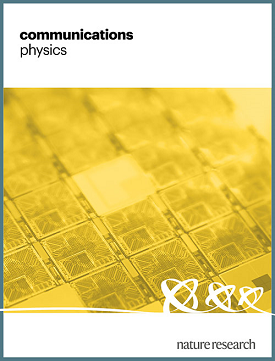Non-equilibrium formation and relaxation of magnetic flux ropes at kinetic scales
IF 5.4
1区 物理与天体物理
Q1 PHYSICS, MULTIDISCIPLINARY
引用次数: 0
Abstract
Magnetic flux ropes are pivotal structures and building blocks in astrophysical and laboratory plasmas, and various equilibrium models have thus been studied in the past. However, flux ropes in general form at non-equilibrium, and their pathway from formation to relaxation is a crucial process that determines their eventual properties. Here we show that any localized current parallel to a background magnetic field will evolve into a flux rope via non-equilibrium processes. The detailed kinetic dynamics are exhaustively explained through single-particle and Vlasov analyses and verified through particle-in-cell simulations. This process is consistent with many proposed mechanisms of flux rope generation such as magnetic reconnection. A spacecraft observation of an example flux rope is also presented; by invoking the non-equilibrium process, its structure and properties can be explicated down to all six components of the temperature tensor. Flux ropes are fundamental structures that govern much of the dynamics in astrophysical and space plasmas. The authors show how out-of-equilibrium processes can form small-scale flux ropes and compare them to simulations and spacecraft observations.


磁通量绳在动力学尺度上的非平衡形成和弛豫
磁通索是天体物理和实验室等离子体中的关键结构和构件,因此过去曾对各种平衡模型进行过研究。然而,磁通索一般是在非平衡状态下形成的,它们从形成到弛豫的过程是决定其最终性质的关键过程。在这里,我们证明了任何与背景磁场平行的局部电流都会通过非平衡过程演变成磁通索。我们通过单粒子和弗拉索夫分析详尽地解释了详细的动力学过程,并通过粒子间模拟进行了验证。这一过程与许多提出的磁通绳产生机制(如磁重联)相一致。此外,还介绍了航天器观测到的一个通量绳示例;通过引用非平衡过程,其结构和特性可以解释到温度张量的所有六个分量。通量绳是支配天体物理和空间等离子体大部分动力学的基本结构。作者展示了非平衡过程如何形成小尺度通量绳,并将其与模拟和航天器观测结果进行了比较。
本文章由计算机程序翻译,如有差异,请以英文原文为准。
求助全文
约1分钟内获得全文
求助全文
来源期刊

Communications Physics
Physics and Astronomy-General Physics and Astronomy
CiteScore
8.40
自引率
3.60%
发文量
276
审稿时长
13 weeks
期刊介绍:
Communications Physics is an open access journal from Nature Research publishing high-quality research, reviews and commentary in all areas of the physical sciences. Research papers published by the journal represent significant advances bringing new insight to a specialized area of research in physics. We also aim to provide a community forum for issues of importance to all physicists, regardless of sub-discipline.
The scope of the journal covers all areas of experimental, applied, fundamental, and interdisciplinary physical sciences. Primary research published in Communications Physics includes novel experimental results, new techniques or computational methods that may influence the work of others in the sub-discipline. We also consider submissions from adjacent research fields where the central advance of the study is of interest to physicists, for example material sciences, physical chemistry and technologies.
 求助内容:
求助内容: 应助结果提醒方式:
应助结果提醒方式:


